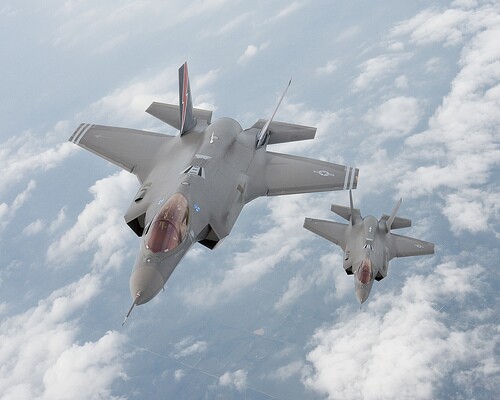The F-35 Joint Strike Fighter (JSF) program continues to rack up the milestones with the F-35B short takeoff/vertical landing (STOVL) variant breaking the sound barrier for the first time. The F-35B, which completed its first vertical landing in March, hit Mach 1.07 (727 miles per hour) in an off-shore test on June 10 and will be put through a series of supersonic flights that will gradually take the aircraft towards its top speed of Mach 1.6.
The F-35B STOVL marks the first time in 100 years of military aviation that a plane has combined radar-evading stealth, VTOL and supersonic speed and may go some way towards justifying the program's other milestone achievement of being the most expensive weapons program in military history.
The idea behind the Joint Strike Fighter program is to build three aircraft with different capabilities from largely common (70% plus) parts. The conventional take-off and landing F-35A will replace the U.S. Air Force F-16s and A-10s as well as taking a place in the the air forces of Italy, Netherlands, Turkey, Canada, Australia, Denmark, Norway. The F-35B STOVL will be used by the U.S. Marine Corps, U.K. Royal Air Force and Royal Navy, Italian Air Force and Navy and the F-35C is a carrier variant which will replace U.S. Navy F/A-18s. There are also two interchangeable engines for the F-35 -the Pratt & Whitney F135 and the GE Rolls-Royce Fighter Engine Team F136.
The Pentagon has plans for purchasing 2,443 JSF Lightning IIs for an estimated USD$323 billion. The F-35 program is led by Lockheed Martin, Northrop Grumman and BAE Systems, has about 900 suppliers in 45 U.S. states, and directly and indirectly employs more than 127,000 people. Thousands more are employed in F-35 partner countries (United Kingdom, Italy, the Netherlands, Turkey, Canada, Australia, Denmark and Norway), which have invested more than USD$4 billion in the project.
It is the most expensive U.S. weapons program ever, and by virtue of the United States' unprecedented dominance of global military expenditure, the most expensive weapons system in history. According to the just released SIPRI Yearbook 2010, America spent US$661 billion in 2009, 43% of ALL global defence spending which total US$1572 billion in 2009.

F-35B breaks the sound barrier
The F-35B known as BF-2 had flown 29 times before U.S. Marine Corps pilot Lt. Col. Matt Kelly took it beyond Mach 1 on June 10. During the flight near Naval Air Station Patuxent River, the aircraft also flew to 30,000 feet and underwent a series of tests to validate roll, pitch, yaw and propulsion performance."For the first time in military aviation history, supersonic, radar-evading stealth comes with short takeoff/vertical landing capability," said Bob Price, Lockheed Martin's F-35 U.S. Marine Corps program manager. "The supersonic F-35B can deploy from small ships and austere bases near front-line combat zones, greatly enhancing combat air support with higher sortie-generation rates." When it enters operation, the F-35B will be capable of Mach 1.6, carry an internal weapons load of more than 3,000 pounds and be able to launch internal missiles and guided bombs at supersonic speeds. It is due to enter service in 2012.
F-35 C makes inaugural flight
The first flight of the F-35C Lightning II carrier variant took place earlier this month. The aircraft flew for just under an hour after taking off from the Naval Air Station Fort Worth Joint Reserve Base under the control of Lockheed Martin Test Pilot Jeff Knowles.[youtube:SZUo99e8wCg&hl=en_US&fs=1&]
The F-35C stealth fighter is tailored for use at sea with "larger wing and control surfaces for safe, precise handling and low approach speeds to the carrier, excellent over-the-nose visibility, and additional structural strength for at-sea operations."
"For the first time ever, and from now on, wherever on the world’s oceans we position a 98,000-ton nuclear carrier, we can launch a long-range, lethal, stealth strike fighter with the ability to defeat the most sophisticated air defenses," said Tom Burbage, Lockheed Martin executive vice president and general manager of F-35 Program Integration.
F-35A ground tests completed
The F-35B BF-2 is not the first aircraft in the program to have achieved supersonic flight. The conventional takeoff and landing variants (F-35A) made Mach 1.05 with a full internal load of dummy weapons in 2008 and has recently completed full-scale static testing on its airframe. Tthe F-35A was tested to 150 percent of design limits or 13.5 G's (force of gravity) at BAE Systems’ Structural & Dynamic Test Laboratory in Brough, England, with zero structural failures.Images: Lockheed Martin.











